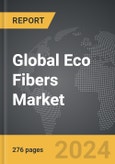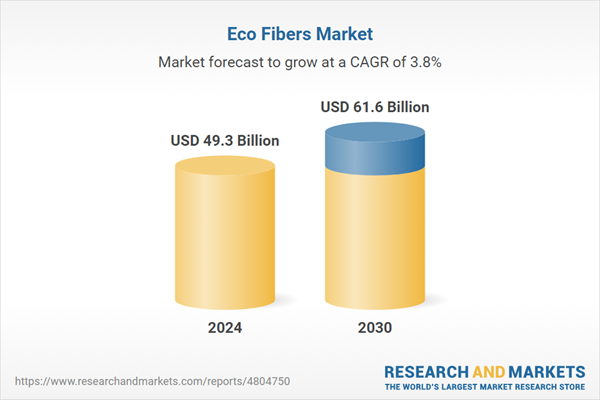The global market for Eco Fibers was valued at US$49.3 Billion in 2024 and is projected to reach US$61.6 Billion by 2030, growing at a CAGR of 3.8% from 2024 to 2030. This comprehensive report provides an in-depth analysis of market trends, drivers, and forecasts, helping you make informed business decisions. The report includes the most recent global tariff developments and how they impact the Eco Fibers market.
Segments: Type (Regenerated Fibers, Natural Fibers, Organic Fibers, Recycled Fibers); Application (Clothing / Textile, Household & Furnishings, Industrial, Medical, Other Applications).
Geographic Regions/Countries: World; United States; Canada; Japan; China; Europe (France; Germany; Italy; United Kingdom; and Rest of Europe); Asia-Pacific; Rest of World.
The analysts continuously track trade developments worldwide, drawing insights from leading global economists and over 200 industry and policy institutions, including think tanks, trade organizations, and national economic advisory bodies. This intelligence is integrated into forecasting models to provide timely, data-driven analysis of emerging risks and opportunities.
Global Eco Fibers Market - Key Trends and Drivers Summarized
What Exactly Are Eco Fibers and Why Are They Gaining Popularity?
Eco fibers, or environmentally friendly fibers, are distinguished by their origin from sustainable sources and their production methods that aim to significantly reduce environmental damage. These fibers encompass natural materials like organic cotton, bamboo, wool, and hemp, as well as regenerated substances such as lyocell and modal, which are derived from renewable cellulosic plants. The surge in their popularity is directly linked to increasing environmental awareness among consumers worldwide, driven by mounting concerns over pollution and resource depletion typically associated with synthetic fibers. As the global community becomes more eco-conscious, the demand for products that align with a sustainable and environmentally responsible lifestyle grows, pushing industries, especially textiles, towards more sustainable solutions. This shift is not merely a trend but a transformation in consumer behavior, reflecting a deep-rooted desire to influence the market towards greener alternatives.How Are Eco Fibers Redefining the Textile Industry?
The adoption of eco fibers is radically transforming the textile industry by integrating sustainability into its core operations. This transformation can be observed from the ground up, starting with agricultural practices for raw materials. Organic farming methods, which are pivotal for cultivating materials like organic cotton, emphasize reducing chemical pesticide and fertilizer use, conserving water, and maintaining soil health. Furthermore, the evolution of textile production technology has enabled the creation of fabrics that maintain high quality and durability without compromising environmental values. These fabrics meet modern consumer demands for style and comfort, bridging the gap between eco-friendly practices and fashion needs. Additionally, innovations in dyeing and finishing processes that utilize less water and non-toxic dyes further reduce the industry’s carbon footprint, underscoring a comprehensive shift towards more sustainable manufacturing processes.What Challenges and Opportunities Exist in the Eco Fibers Market?
Despite the promising growth of the eco fibers market, several challenges persist that could potentially stifle its expansion. The most significant is the increased cost of sustainable production methods, which often results in higher-priced final products. This price increase can be a deterrent for consumers, particularly in economically sensitive regions. However, these challenges also present opportunities for innovation in reducing production costs and improving supply chain efficiencies. The push towards sustainability is also creating new market niches that prioritize environmental impact in their purchasing decisions, offering substantial growth opportunities for businesses that can innovate and scale eco-friendly solutions effectively. Furthermore, legislative changes and stricter environmental regulations are likely to bolster the market, as they push the industry towards sustainable practices by making non-compliance costlier and eco-friendliness more economically attractive.What Drives the Expansion of the Eco Fibers Market?
The growth in the eco fibers market is driven by several factors, notably the shift in consumer preferences towards sustainability, propelled by increased awareness of environmental issues. This shift is further supported by governmental actions, such as the imposition of stricter environmental regulations and incentives for sustainable practices, which encourage manufacturers to adopt eco-friendly materials. Technological advancements that enhance the cost-effectiveness and efficiency of eco fiber production are also critical, as they help lower the price barriers associated with sustainable products, making them more accessible to a wider audience. The influence of social media and the increasing role of influencers in promoting sustainable fashion have also played a pivotal role in popularizing eco fibers. As the global consumer base becomes more environmentally conscious, the demand for products made with eco fibers is expected to continue growing, supported by ongoing innovations in technology and a robust regulatory framework that favors environmental stewardship.Report Scope
The report analyzes the Eco Fibers market, presented in terms of units. The analysis covers the key segments and geographic regions outlined below.Segments: Type (Regenerated Fibers, Natural Fibers, Organic Fibers, Recycled Fibers); Application (Clothing / Textile, Household & Furnishings, Industrial, Medical, Other Applications).
Geographic Regions/Countries: World; United States; Canada; Japan; China; Europe (France; Germany; Italy; United Kingdom; and Rest of Europe); Asia-Pacific; Rest of World.
Key Insights:
- Market Growth: Understand the significant growth trajectory of the Regenerated Fibers segment, which is expected to reach US$32.0 Billion by 2030 with a CAGR of a 2.8%. The Natural Fibers segment is also set to grow at 4.7% CAGR over the analysis period.
- Regional Analysis: Gain insights into the U.S. market, valued at $13.1 Billion in 2024, and China, forecasted to grow at an impressive 3.7% CAGR to reach $9.9 Billion by 2030. Discover growth trends in other key regions, including Japan, Canada, Germany, and the Asia-Pacific.
Why You Should Buy This Report:
- Detailed Market Analysis: Access a thorough analysis of the Global Eco Fibers Market, covering all major geographic regions and market segments.
- Competitive Insights: Get an overview of the competitive landscape, including the market presence of major players across different geographies.
- Future Trends and Drivers: Understand the key trends and drivers shaping the future of the Global Eco Fibers Market.
- Actionable Insights: Benefit from actionable insights that can help you identify new revenue opportunities and make strategic business decisions.
Key Questions Answered:
- How is the Global Eco Fibers Market expected to evolve by 2030?
- What are the main drivers and restraints affecting the market?
- Which market segments will grow the most over the forecast period?
- How will market shares for different regions and segments change by 2030?
- Who are the leading players in the market, and what are their prospects?
Report Features:
- Comprehensive Market Data: Independent analysis of annual sales and market forecasts in US$ Million from 2024 to 2030.
- In-Depth Regional Analysis: Detailed insights into key markets, including the U.S., China, Japan, Canada, Europe, Asia-Pacific, Latin America, Middle East, and Africa.
- Company Profiles: Coverage of players such as David C. Poole Company, Inc., Grasim Industries Ltd., Lenzing AG, Polyfibre Industries Pvt Ltd., Shanghai Tenbro Bamboo Textile Co., Ltd. and more.
- Complimentary Updates: Receive free report updates for one year to keep you informed of the latest market developments.
Some of the 47 companies featured in this Eco Fibers market report include:
- David C. Poole Company, Inc.
- Grasim Industries Ltd.
- Lenzing AG
- Polyfibre Industries Pvt Ltd.
- Shanghai Tenbro Bamboo Textile Co., Ltd.
- Tangshan Sanyou Group Xingda Chemical Fibre Co., Ltd.
- Teijin Ltd.
- US Fibers
Tariff Impact Analysis: Key Insights for 2025
Global tariff negotiations across 180+ countries are reshaping supply chains, costs, and competitiveness. This report reflects the latest developments as of April 2025 and incorporates forward-looking insights into the market outlook.The analysts continuously track trade developments worldwide, drawing insights from leading global economists and over 200 industry and policy institutions, including think tanks, trade organizations, and national economic advisory bodies. This intelligence is integrated into forecasting models to provide timely, data-driven analysis of emerging risks and opportunities.
What’s Included in This Edition:
- Tariff-adjusted market forecasts by region and segment
- Analysis of cost and supply chain implications by sourcing and trade exposure
- Strategic insights into geographic shifts
Buyers receive a free July 2025 update with:
- Finalized tariff impacts and new trade agreement effects
- Updated projections reflecting global sourcing and cost shifts
- Expanded country-specific coverage across the industry
Table of Contents
I. METHODOLOGYII. EXECUTIVE SUMMARY2. FOCUS ON SELECT PLAYERSIII. MARKET ANALYSISIV. COMPETITION
1. MARKET OVERVIEW
3. MARKET TRENDS & DRIVERS
4. GLOBAL MARKET PERSPECTIVE
UNITED STATES
CANADA
JAPAN
CHINA
EUROPE
FRANCE
GERMANY
ITALY
UNITED KINGDOM
REST OF EUROPE
ASIA-PACIFIC
REST OF WORLD
Companies Mentioned (Partial List)
A selection of companies mentioned in this report includes, but is not limited to:
- David C. Poole Company, Inc.
- Grasim Industries Ltd.
- Lenzing AG
- Polyfibre Industries Pvt Ltd.
- Shanghai Tenbro Bamboo Textile Co., Ltd.
- Tangshan Sanyou Group Xingda Chemical Fibre Co., Ltd.
- Teijin Ltd.
- US Fibers
Table Information
| Report Attribute | Details |
|---|---|
| No. of Pages | 276 |
| Published | April 2025 |
| Forecast Period | 2024 - 2030 |
| Estimated Market Value ( USD | $ 49.3 Billion |
| Forecasted Market Value ( USD | $ 61.6 Billion |
| Compound Annual Growth Rate | 3.8% |
| Regions Covered | Global |









